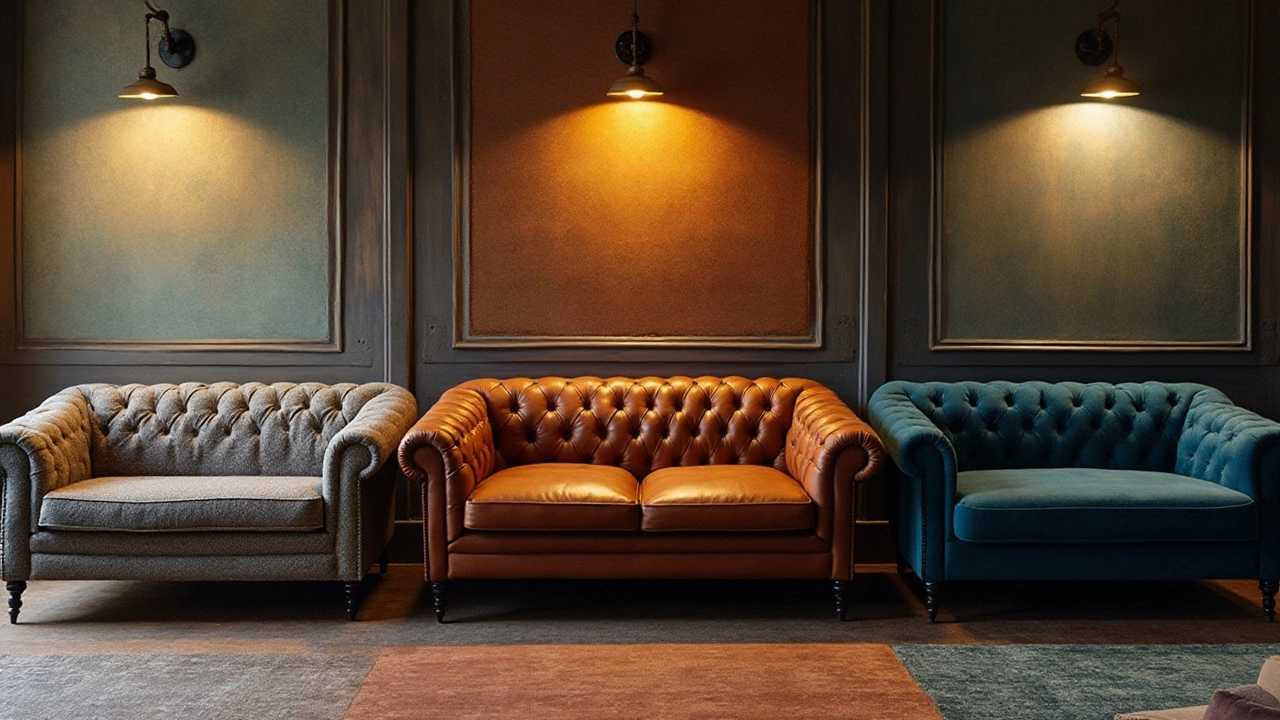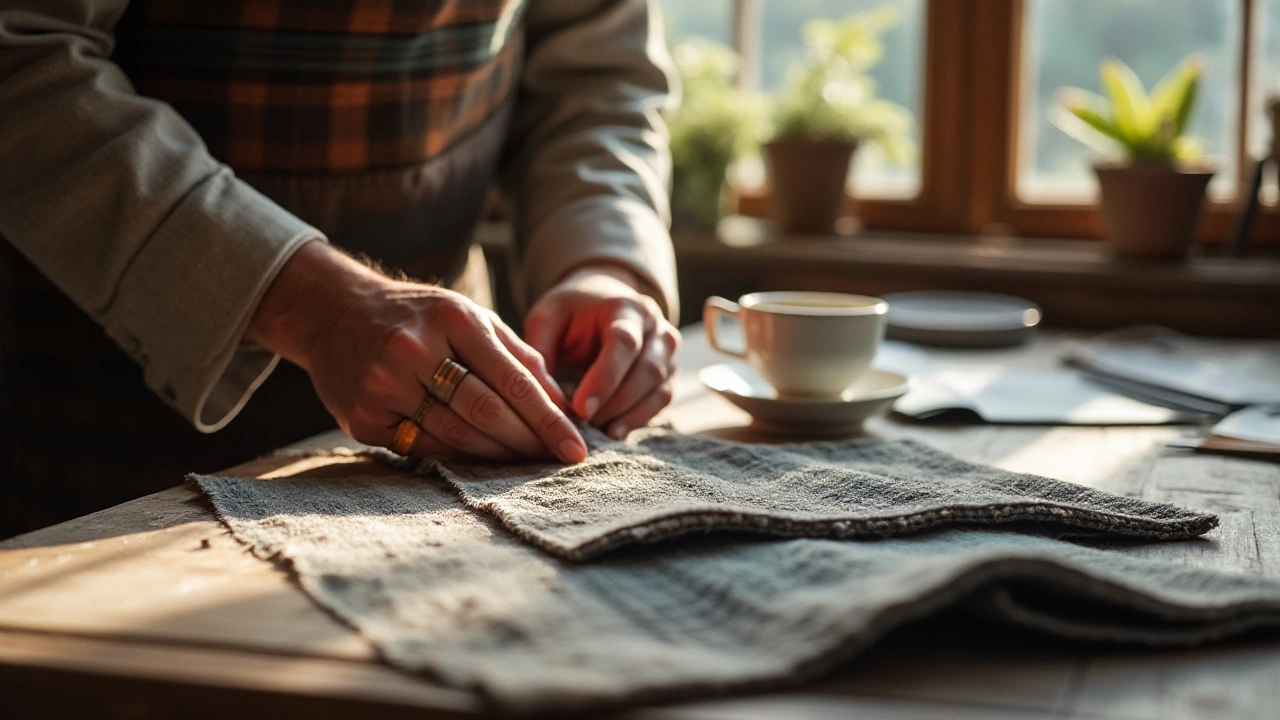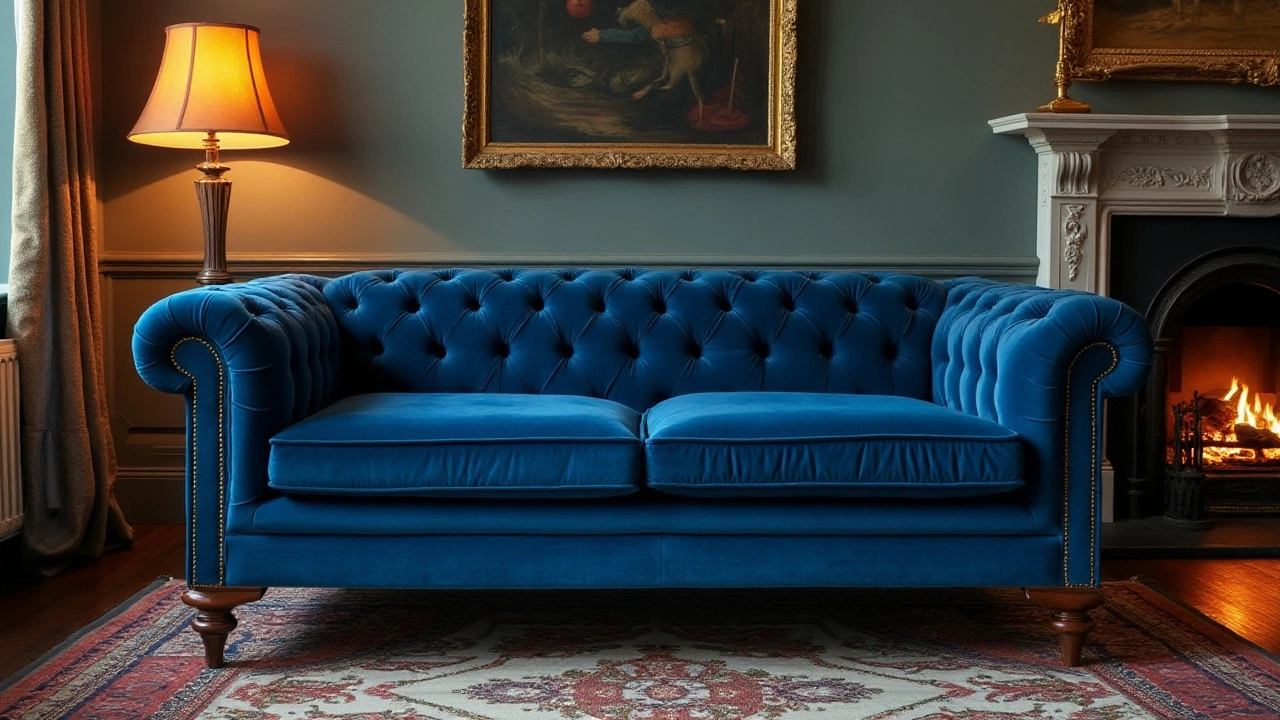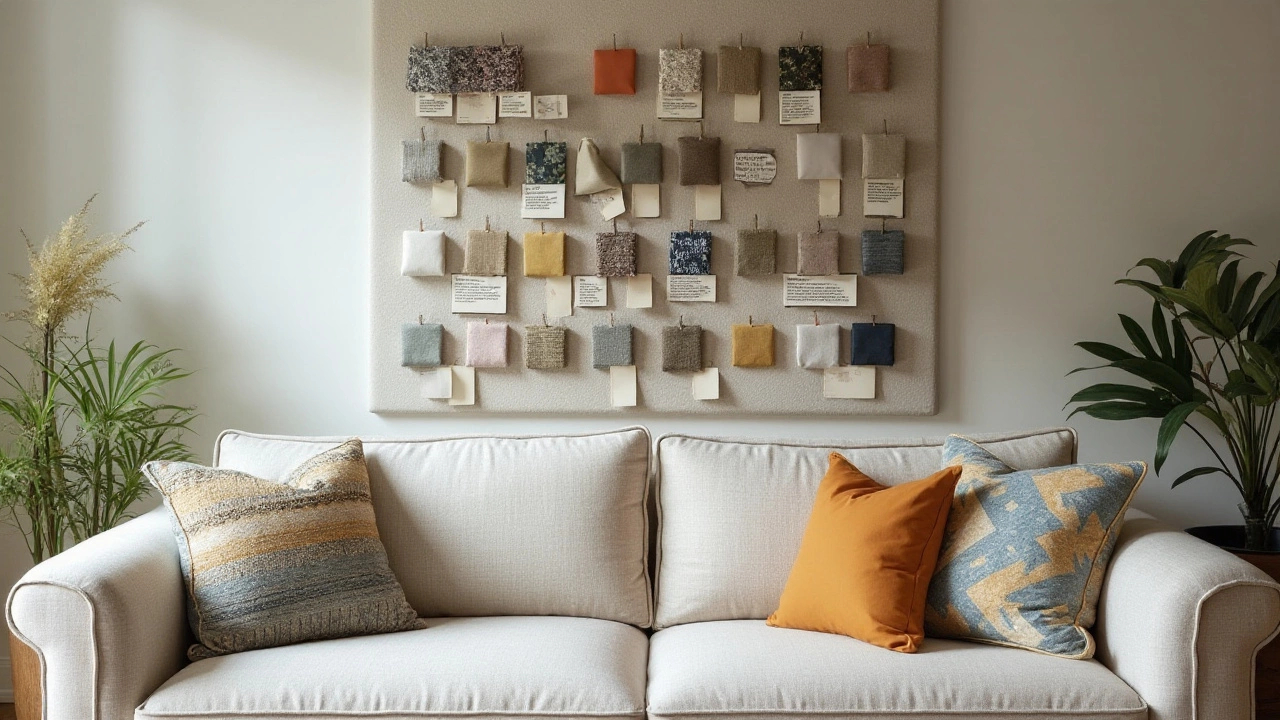Discover the Most Durable Couch Fabrics for Lasting Comfort
 Jan, 10 2025
Jan, 10 2025
In the world of sofas, not all couch fabrics are created equal. When selecting a couch, it's vital to consider a fabric that not only looks appealing but also withstands everyday wear and tear. Picking a fabric that lasts can transform your seating experience and even save you money in the long run.
Whether you're dealing with kids, pets, or simply love hosting, certain materials might outshine the others. We'll unravel the mystery surrounding couch fabrics so you can make an informed decision. Dive into this guide to learn about the differences in fabric durability and find out which materials are built to last.
- Understanding Fabric Durability
- Top Long-Lasting Fabrics
- Everyday Maintenance Tips
- Choosing the Right Fabric for You
Understanding Fabric Durability
Sofas are more than mere furniture; they are pivotal to our living spaces and are subjected to a fair amount of wear and tear. When considering **couch fabric**, understanding its durability is fundamental. But what makes one fabric more durable than another? It's a synergy between fiber strength, weave tightness, and treatment, each contributing to the whole. Natural fibers like cotton and linen possess a charm of their own, but when assessing endurance, synthetic blends often have the upper hand. Upholstery can vary dramatically in resilience, so grasping the fabric's characteristics is crucial for long-term satisfaction. Consumers are increasingly drawn to choices like microfiber, which is not only soft but also deceptively rugged. Leather, too, remains a powerhouse, often synonymous with luxury, while offering commendable longevity.
Consider the elements: fabric strength isn't just about its origin or type—it's sometimes about how it's made. Weave tightness, for example, plays a critical role. For instance, a tightly woven fabric will naturally resist ripping and stretching better than a loosely woven one. This tight weave can also aid in stain resistance, marking another check in the column for durability. The treatment of the fabric before sale is another factor. Many upholstery fabrics undergo special treatments to become water and stain-resistant, thereby extending their lifespan in bustling households. A surprising choice that many wouldn't initially consider is outdoor fabric. Designed to withstand the cruelty of the elements, these fabrics can be cleverly utilized indoors for families with kids or pets, where spills and stains are frequent guests.
As the legendary American designer, Charles Eames once said,
"The details are not the details. They make the design."This sentiment perfectly encapsulates the essence of choosing the right fabric. It is not merely the material itself but the cumulative detail of fiber type, weave, and treatment that creates the canvas for a durable, life-resistant sofa.
| Fabric Type | Strength | Maintenance |
|---|---|---|
| Microfiber | High | Easy |
| Leather | Very High | Medium |
| Cotton Blend | Medium | Moderate |
In essence, each fabric's endurance is a dance between these elements and your specific needs, whether it is facing a household brimming with the joyful chaos of children or basking in the serene elegance of a minimalistic setting. The ideal choice aligns with your lifestyle and personal preferences. Thus, an educated choice in selecting **durable sofas** finally boils down to one ultimate aim: to ensure that your sofa remains a steadfast companion in your home's narrative.

Top Long-Lasting Fabrics
When considering a fabric for your couch, it's essential to think about how it will endure the daily grind of life. Some materials stand out for their endurance and ease of care, proving that not all upholstery is created equally. Let's delve into the top performers you might want to consider for their strong reputation for durability. Durable sofas rely on the strength and resilience of their fabric, making it a crucial choice for longevity.
One of the top choices for long-lasting couch fabrics is leather. Leather not only has a luxurious and classic appearance but also boasts impressive durability. It ages gracefully, often acquiring a sophisticated patina, adding character with each passing year. Many homeowners appreciate leather for its ability to resist spills and stains, making it a fantastic option for families with children or pets. Of course, leather requires some level of maintenance––regular conditioning can help preserve its suppleness and prevent cracks.
Another premium choice for long-lasting materials is microfiber. Known for its ability to withstand significant wear and tear, microfiber is a synthetic fabric that offers a soft, plush feel and great versatility in design. It’s densely woven, making it robust and resistant to scratches, stains, and spills. Households with pets often lean towards microfiber, as it’s less likely to show marks from claws and paws. The fabric also comes in a variety of colors, enabling you to match your sofa to any room style.
For those preferring a more traditional fabric, wool and wool blends provide excellent strength and resilience. Wool has natural dirt-repelling qualities and is highly breathable, offering comfort in both warm and cooler climates. While it might not be the first choice for everyone due to its texture, wool has a unique ability to retain its shape and resist piling, contributing to its durability.
According to a survey conducted by the National Home Furnishings Association, "Microfiber tops the list for the most recommended couch fabric for durability and ease of care, preferred by 65% of households surveyed with children and pets."
Lastly, consider tightly woven fabrics like twill. Twill is known for its distinctive diagonal weave, which creates a sturdy texture that is both attractive and functional. It might not appear as luxurious as leather or as soft as microfiber, but its strength lies in its structure. Twill is resistant to wrinkles and creasing, making it a reliable choice for those looking to maintain a neat appearance.
Here's a comparison of some key attributes of these fabrics that consumers often consider:
| Fabric | Durability | Maintenance | Best For |
|---|---|---|---|
| Leather | High | Moderate | Classic look, pet resistance |
| Microfiber | Very High | Low | Pet-friendly, low maintenance |
| Wool | High | Low | Traditional, temperature control |
| Twill | High | Low | Resistance to wear, neat appearance |
Choosing the right fabric means weighing these attributes against your lifestyle needs. Each material brings its own set of advantages, making it easier to zero in on what's genuinely important for your home environment. By understanding these details, you can make an informed decision, ensuring your investment in a sofa that will stand the test of time.

Everyday Maintenance Tips
To ensure your couch fabric remains durable and retains its beauty for years, regular maintenance is essential. A consistent cleaning schedule prevents dirt from embedding into the fibers and protects against the wear and tear of daily use. Vacuuming your sofa weekly is a great way to remove dust and prevent the growth of dust mites, as these can contribute to fabric breakdown and discoloration. For the best results, use a vacuum attachment with a brush to gently loosen particles without damaging the fabric. It's also worth investing in a fabric protector spray to add a layer of defense against spills, which can happen at the most unexpected times.
Handle Spills Quickly and Efficiently
Spills are inevitable, but handling them promptly can prevent stains and keep your couch looking fresh. Blotting a spill with a clean, absorbent cloth is often more effective than rubbing, which can drive the liquid deeper into the fabric. If you're dealing with a long-lasting material like microfiber or leather, use a cleaner specifically designed for these surfaces. As a bit of an insider tip, many durable couches have removable covers that are machine washable. Check yours to see if it's one of them, and if so, washing the covers as per the manufacturer's instructions can rejuvenate the fabric.
The Protective Power of Slip Covers
Slip covers serve as a versatile solution for renewing your couch's appearance while providing extra protection. Especially if your couch is placed in a high-traffic area, these covers can absorb daily bumps and spills that can accumulate over time. For families with children or pets, having additional slip covers allows for easy swaps; simply throw one in the wash while another guards your sofa. With numerous designs and colors available, they also offer a fun way to change your room's look.
Regular Rotation of Cushions
Rotating cushions periodically helps distribute wear evenly across your couch fabric. Without rotation, cushions can wear out unevenly and quickly, especially in spots that are favored. Fluffing and switching the sides of your cushions ensures they keep their shape longer, preventing sagging which can lead to more wrinkles and stress on any fabric. It’s a small step that can greatly enhance the comfort and longevity of your couch. Don't forget to check for loose threads or pulls while handling the cushions, as addressing these early can stop small issues from turning into bigger problems.
Understanding Temperature and Humidity Effects
It's important to be mindful of how room climate can affect your sofa. Fabrics can either shrink or warp with shifts in humidity levels, which can affect fit and appearance. Keeping your home at a steady temperature and humidity range can preserve the integrity of all your furnishings, including your couches. For leather and certain natural fibers, occasional conditioning with the appropriate products helps maintain softness and prevent cracking. Surprisingly, little steps like these contribute significantly to making a fabric not just last, but continue to look magnificent.

Choosing the Right Fabric for You
When choosing couch fabric, tailoring your selection to your household’s needs can make all the difference. Your lifestyle plays a significant role in this choice. For example, if you have children or pets, going for a fabric that resists stains and scratches is advisable. Classic materials like leather or synthetic options like microfiber can be excellent choices. Real leather is known for its durability and can develop a unique patina over time, making it even more attractive. Likewise, microfiber offers a range of colors while being resistant to spills, without sacrificing comfort or style.
Durability isn't the only factor to consider. If you're someone who prefers eco-friendly options, consider natural fibers like cotton and linen. Though they may not be the most resilient against wear, they offer a range of benefits including being relatively easy to clean and breathable, which can be a godsend during warmer months. Remember, choosing the right fabric might mean a compromise between longevity and other desirable attributes like environmental impact or aesthetic appeal. It's all about balancing your priorities.
Budget and Care
Your budget might have the final say in your fabric choice, yet it doesn't have to limit quality. Sometimes sophisticated durability and style are only slightly more expensive than their lower-quality counterparts. If you’re working with a tighter budget, you may still find stylish yet long-lasting options like polyester blends, proving that longevity can sometimes come at an affordable price. However, remember that maintenance plays a crucial role in the longevity of fabric, regardless of choice. Regular vacuuming and rotating cushions can extend your sofa’s life considerably. Investing in a fabric protector could also ensure your couch remains a centerpiece for years to come.
For those willing to spend more for premium materials, wool can be an excellent choice. Aside from being fire-resistant, it offers a naturally soft touch and maintains its shape well. On the downside, it may require professional cleaning to maintain its texture and durability. Here, choosing a fabric aligns with an intersection of budget, lifestyle, and the look you desire.
Style and Comfort
The fabric you choose substantially impacts the comfort and aesthetics of your sofa. If you prioritize comfort above all else, velvet might catch your fancy with its luxurious feel, yet it may not be the most durable option if your sofa sees heavy use. Matching your sofa fabric's color and texture to your room's decor gives you a cohesive look. Consider your current interior design – are you going for a minimalist, modern vibe or a more traditional, classic setting? Textured fabrics like tweed can add both depth and interest, while sleeker, solid fabrics work well in contemporary homes. Delicately balancing these factors ensures that your chosen fabric doesn’t just serve practical needs but enhances your living space.